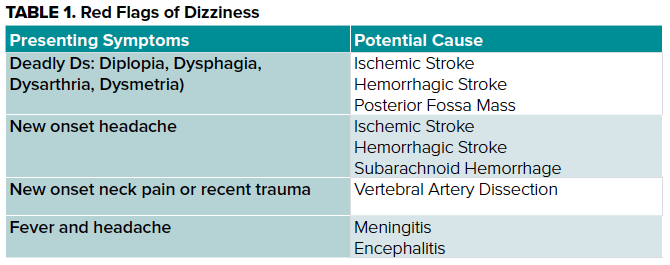Pearls - 8/4/20: Dizziness Remix w/ Dr. Nidiry
FACULTY MORNING REPORT ~ 7/29/20
Dr. Nidiry presented a patient with persistent dizziness.
Your initial history in a patient with dizziness should evaluate for two things:
- RED FLAGS
- Is this dizziness episodic or continuous?
ARE YOU WORRIED?
 |
| Borrowed from: https://www.emra.org/emresident/article/dizziness/ |
IS THIS PATIENT REPORT DIZZINESS THAT EPISODIC OR CONTINUOUS?
 |
| https://www.aafp.org/afp/2017/0201/p154.html |
A patient with episodic dizziness likely has one of the more benign causes listed above. 

If a patient has continuous dizziness and/or alarm signs, this is concerning for a central cause of vertigo & they should have a HINTS plus exam:
THE HINTS EXAM:
Kattah, J. et al. "HINTS to Diagnose Stroke in the Acute Vestibular Syndrome: Three-Step Bedside Oculomotor Examination More Sensitive Than Early MRI Diffusion-Weighted Imaging". Stroke. 2009. 40(11):3504–3510.HINTS is a 3-part oculomotor physical exam designed to help differentiate between a peripheral and central etiology of vertigo.
WOAH MOMENT ~ THE STUDY CITED ABOVE DEMONSTRATED THAT THE HINTS EXAM IS MORE SENSITIVE THAN MRI FOR DIAGNOSING ACUTE STROKE IN PATIENTS WITH DIZZINESS.
BUT REMEMBER ONLY for use in patients with ongoing/continuous vertigo.

✓Any one of the 3 tests (HIT, nystagmus or skew) are positive
✓No history of recurrent vertigo
BUT REMEMBER ONLY for use in patients with ongoing/continuous vertigo.
THE THREE COMPONENTS

Rainer, Spiegel et. al. Dizziness in the emergency department: an update on diagnosis. Swiss Med Wkly. 2017;147:w14565. https://doi.org/10.4414/smw.2017.14565.
h-HIT (Horizontal head impulse test):
- How to:
- Ask patient to focus on your nose.
- Rotate the patient's head 20-40 degrees to the right or left
- Observe for nystagmus. Watch for one eye to lag and then catch up with a quick saccade.
- Lots of examples starting at 15 minutes in this video: https://www.youtube.com/watch?v=XpghlvnrREI
- Normal result in peripheral vertigo: One eye will lag and then catch up with a quick saccade.
- HINTS positive: If there is no lag/saccade & the patient's eyes stay fixed on your nose.
Nystagmus:
- How to:
- Observe the patient & have them move their eyes laterally.
- Normal Result: If nystagmus is present it should be unidirectional.
- HINTS positive: If any other type of nystagmus is seen (vertical, bidirectional).
- Video example at 2:30 --> https://www.youtube.com/watch?v=1q-VTKPweuk
Skew:
- How to:
- Alternately cover one eye and then the other without touching the patient. Watch for vertical or diagonal movement of the uncovered eye.
- Normal Result: No eye movement.
- HINTS positive: Vertical or diagonal movement of the uncovered eye.
- Video example at 3:35 --> https://www.youtube.com/watch?v=1q-VTKPweuk
HINTS exam Positive (i.e. central) if:
✓Patient with at least 1 stroke risk factor✓Any one of the 3 tests (HIT, nystagmus or skew) are positive
✓No history of recurrent vertigo
HINTS Exam operating characteristics according to the Kattah et al study: “100% sensitive and 96% specific for stroke”
What is the HINTS PLUS exam? This means doing the hints exam PLUS evaluating for the following:
MULTIPLE SCLEROSIS IN MINORITY POPULATIONS
As her final teaching point, Dr. Nidiry taught us about that MS is observed to have a more aggressive course in LatinX and Black communities in the US. The reason for this is uncertain but patients in these groups should be cared for thoughtfully and carefully with this in mind.



Comments
Post a Comment